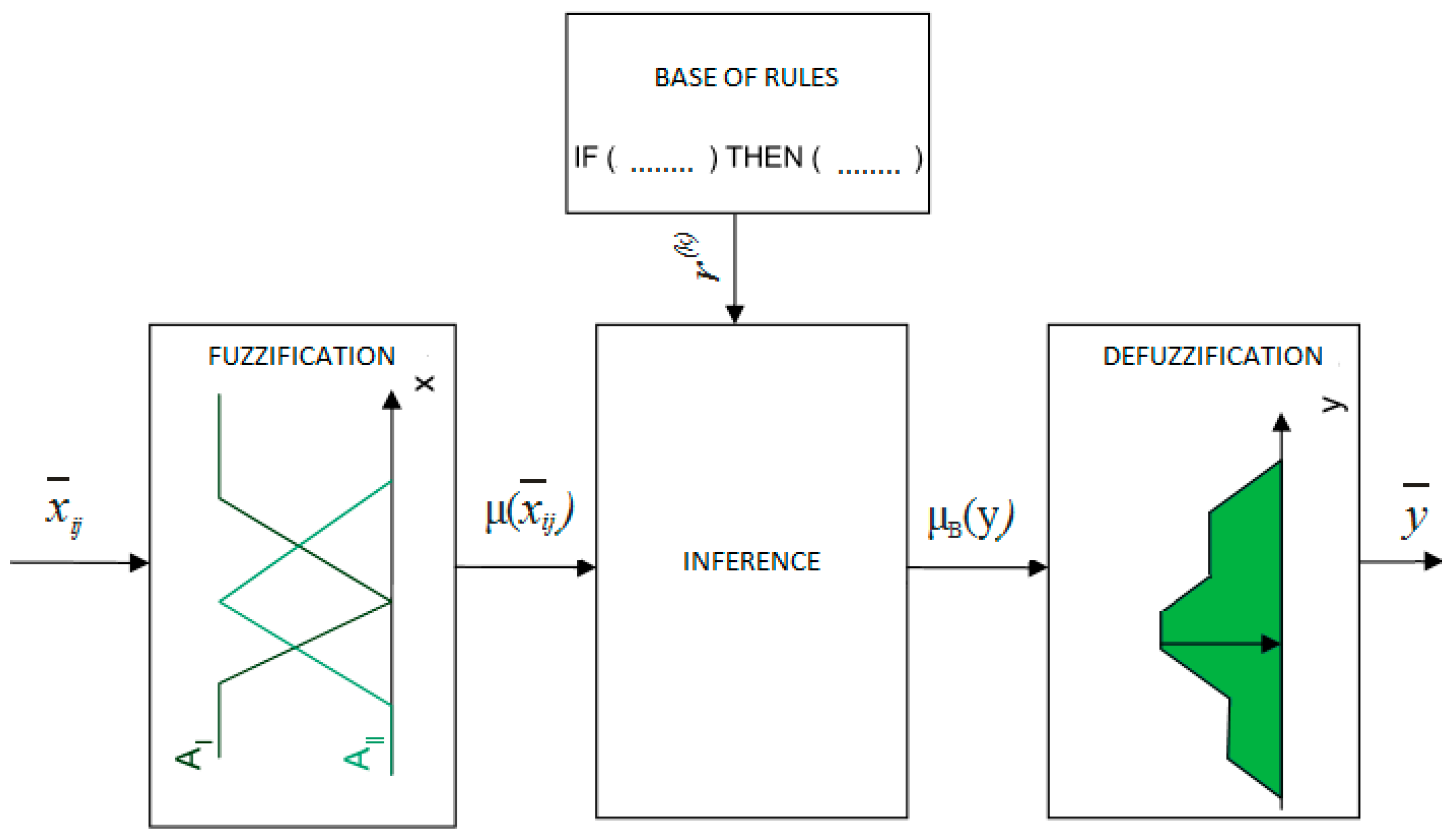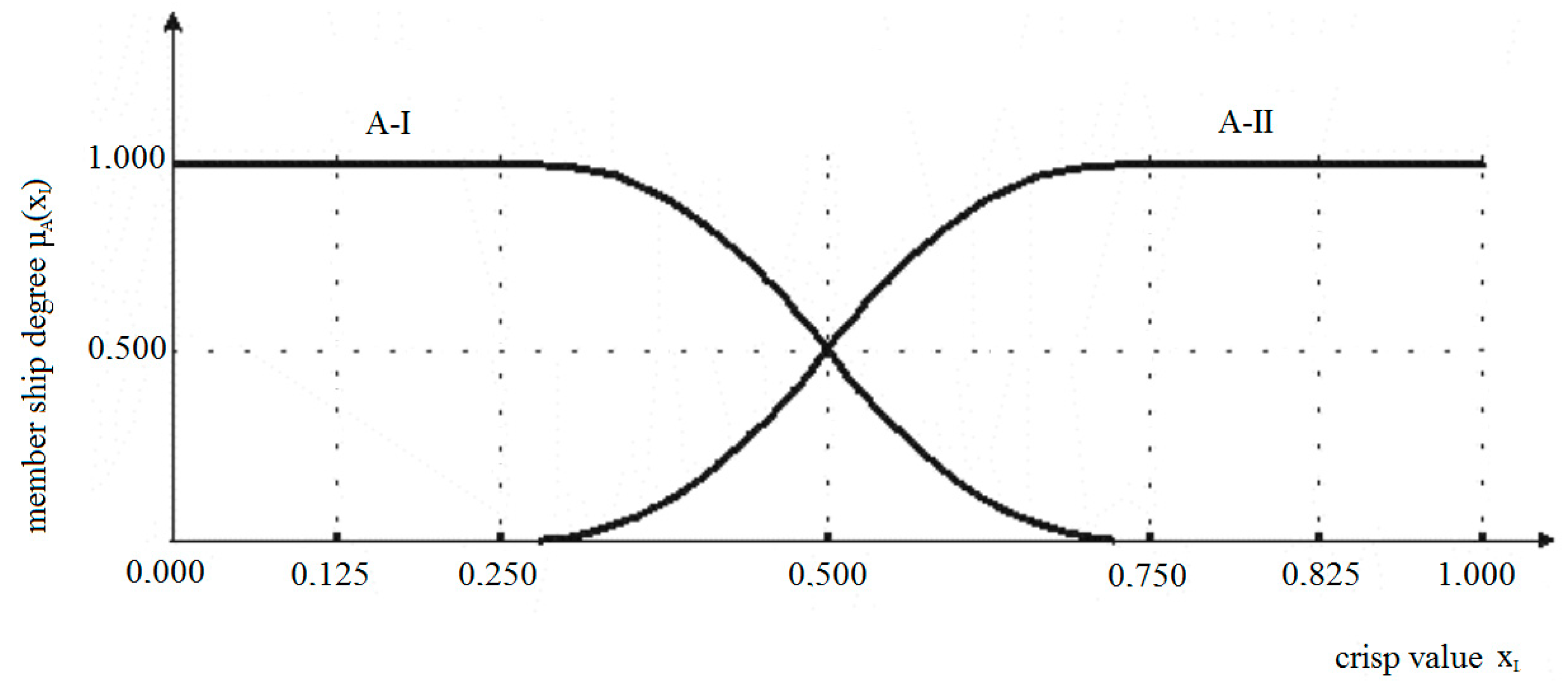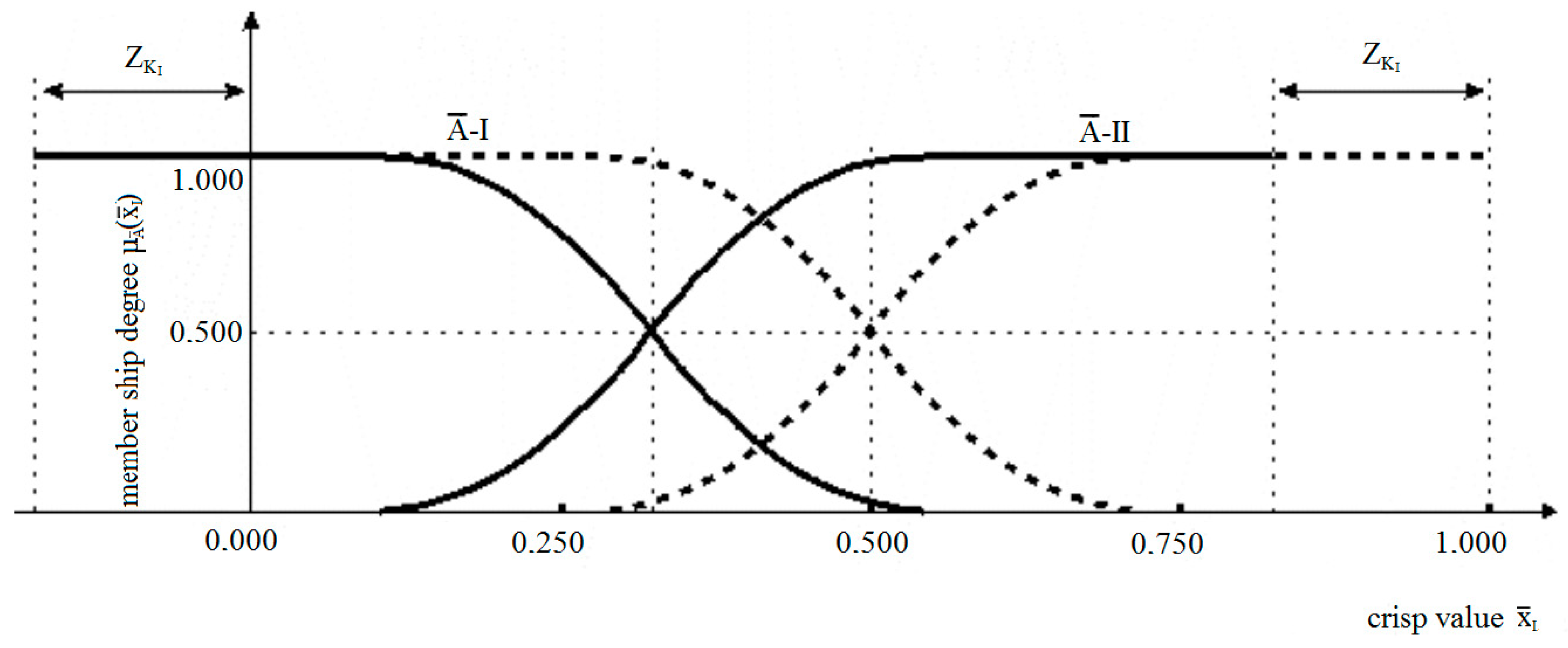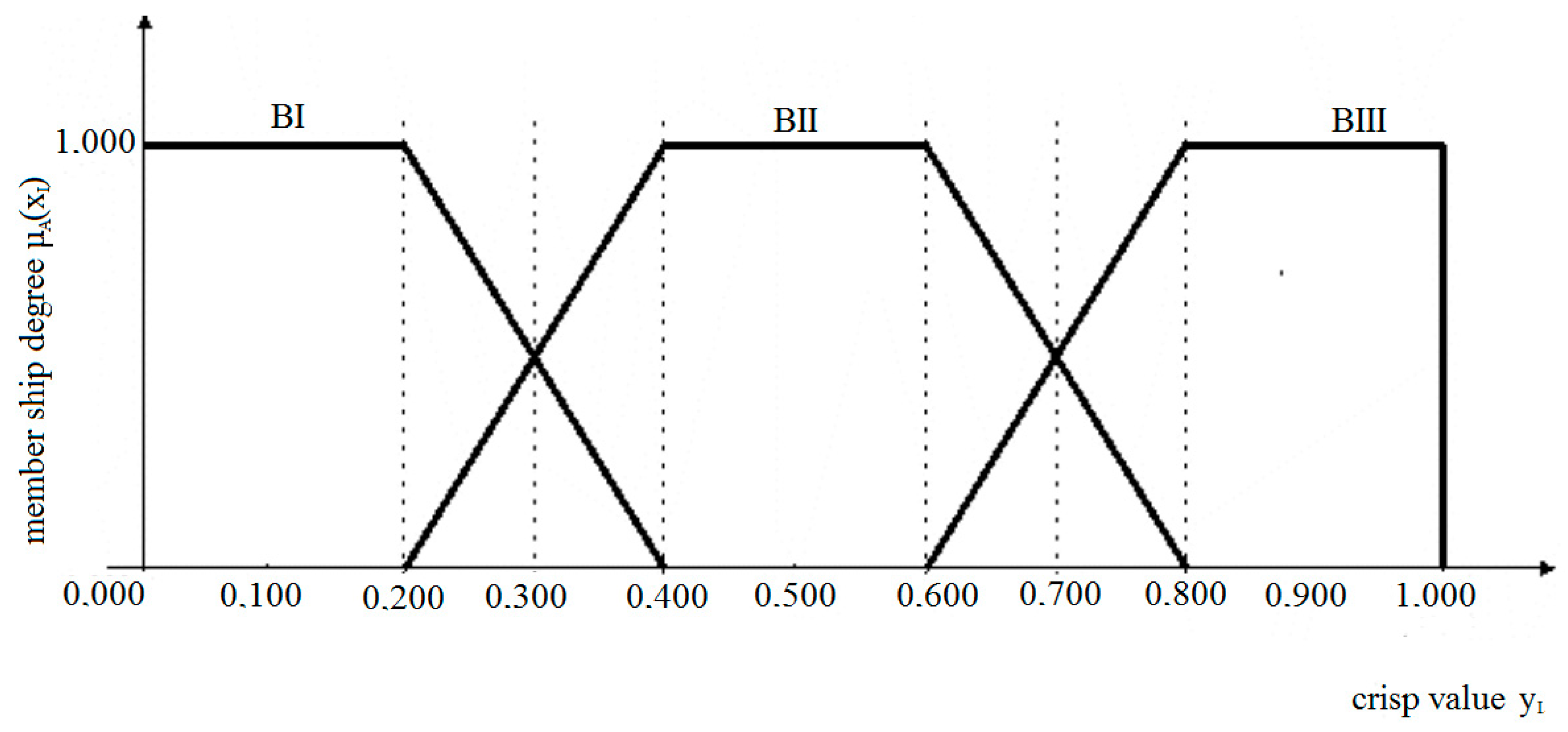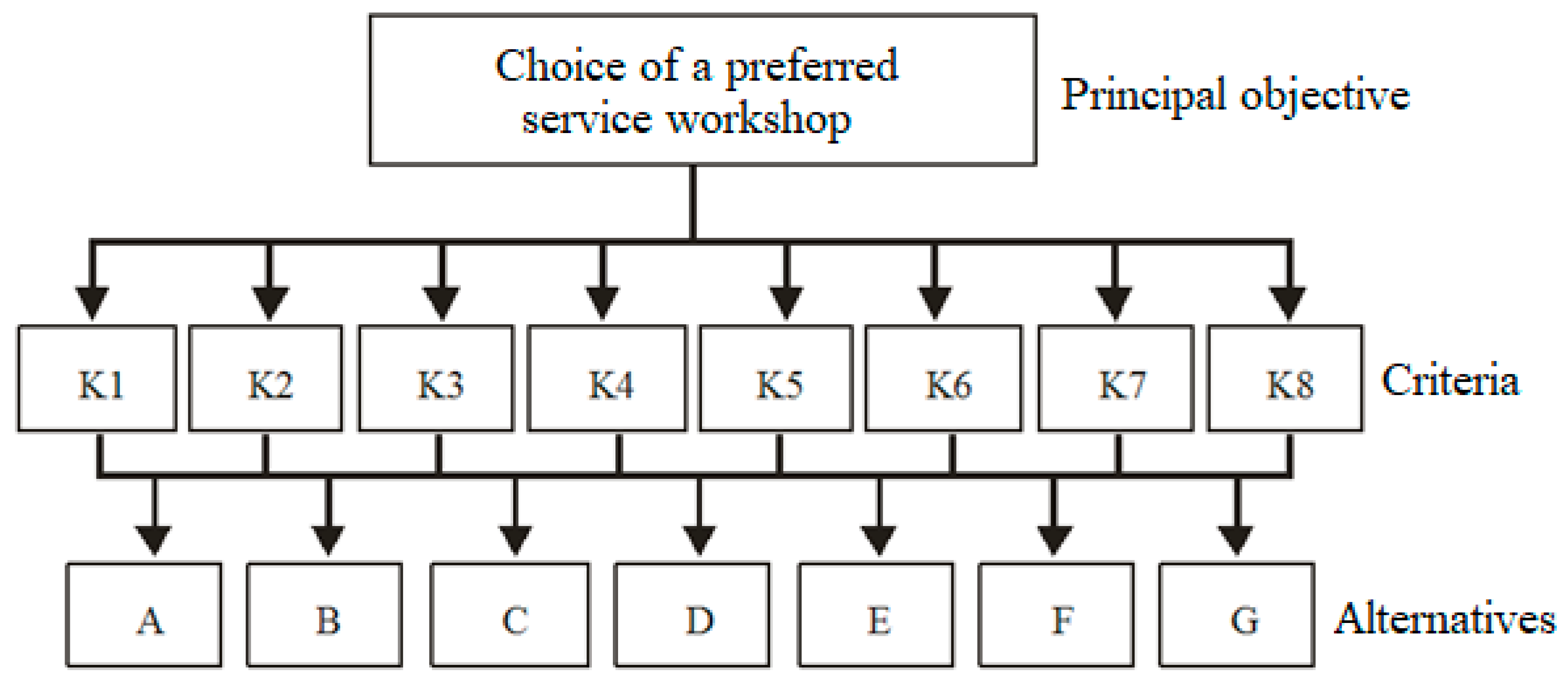The aim of this research is to present a method using fuzzy logic to support the decision-making processes involved in choosing a service workshop. The choice of this method is justified by the fact that fuzzy logic allows the possibility of considering measurable and non-measurable features.
The method herein was built independently on the basis of fuzzy inference theory. In order to verify the method, a survey was conducted among 25 farm owners. The method was also checked on other cases. This method can be used both for one decision-maker and for many decision-makers.
2.1. Background on Fuzzy Logic
The introduction of the concept of fuzzy sets and the theory of fuzzy sets was motivated by the need to mathematically describe occurrences that are ambiguous and imprecise. In the theory of fuzzy sets, one can speak about the partial belonging of a point to the considered set. Instead of zeros and ones (0 or 1), fuzzy logic enables the use of linguistic variables. They assume imprecise values and concepts of spoken language. If something is warm, it is not cold or hot. If something is gray, it is not black or white. Fuzzy logic also allows us to describe features that cannot be expressed in numbers. It allows us to describe occurrences of an ambiguous nature that cannot be described in binary terms [
22,
23,
24].
The notion of fuzzy sets was conceived in 1965 by the American researcher L. A. Zadeh. It was formed as an alternative to classic notions concerning set theory and logic, dating back to times of ancient Greek philosophy. This tool was intended for the modelling of complex processes. In the theory of fuzzy sets, the properties of fuzzy logic are exploited. This is applied for the modelling and guidance of complex systems [
23,
24,
25,
26,
27]. The foundation and development of fuzzy logic resulted from the need to describe occurrences that are difficult to describe using classical mathematics. The model of fuzzy logic consists of three main components: fuzzification, inference, and defuzzification [
24,
28,
29,
30]. Together, they provide completeness and totality (
Figure 1).
The fuzzification component carries out operations of fuzzifying input values to the model (e.g., number of employees of the service unit, charge) or of fuzzy sets (e.g., experience of employees). On accessing the inference block, a fuzzy value appears, where the ultimate membership function of the conclusion of the rule base is determined as the basic element. In the last block, the membership function of the conclusion in one pungent value is acquired. This constitutes the output from the model corresponding to the input values.
2.2. Methods
The proposed method allows a numerical value of the choice of agricultural machines to be obtained. On entry to the fuzzy system, one should define the shape of the membership function, giving the area of the choices X in the closed range [0, 1].
The input sets
A-i of the method comprise two terms, each of them expressing a linguistic assessment of adopted criteria. The A-I set constitutes low evaluations (expense of after-sales service, lack of spare parts, lack of appropriate equipment), while the A-II set constitutes high evaluations (acceptable price for performed services, unlimited access to spare parts, modern diagnostic systems). In
Figure 2, the set membership functions of the input sets
A-i of the fuzzy model are described.
The established input sets
A-i in the fuzzy model were modified. The weight values of the criteria
(which were determined by farmers, where farmers assume the role of experts) were used to modify the input sets. The alteration of sets consists of moving them toward the axis of the value of the function fixtures
, with the value
appointed using Equation (1):
where
n is the number of terms of the input set of the fuzzy model.
Moving the input sets
A-i with the value
allows for including the hierarchization of criteria for the choice of service workshop and appointing new input sets
. The values
for criteria of smaller weight acquire a lower grade in the fuzzification of the fuzzy logic model; those with greater weight have a larger degree of membership (
Figure 3).
The rule base (linguistic model) is interpreted as the set of cause-and-effect relationships which occur among input sets and output sets (which are still fuzzy sets). Every rule consists of the part IF, called the predecessor, which is a set of conditions, and the part THEN, called the apodosis, containing the conclusion. For example, IF the price of services provided is low AND mobile services are provided AND there is good access to spare parts AND there are a large number of qualified mechanics AND there are modern diagnostic systems AND it is a short distance to the service workshop AND services rendered are of good quality AND other farmers have a good opinion of the service center THEN the service center is very good.
Fulfilling individual rules allows us to calculate the degree of activation of the conclusion in the form of the membership function . Combining individual functions provides the ultimate membership function for the conclusion of the rule base. The substantial number of combinations of rules requires the establishment of a base containing only the most characteristic premises and conclusions for the analyzed variant. Extreme, contradictory, and illogical rules are omitted (e.g., IF the price of services provided is low AND mobile services are provided AND there is good access to spare parts AND there are a large number of qualified mechanics AND there are modern diagnostic systems AND it is a short distance to the service facility AND services rendered are of good quality AND other farmers have a good opinion of the service center THEN the service facility is very bad).
Defuzzification is the next stage of fuzzy logic modelling. It includes the process of importing the fuzzy set
B(
y) to one value
. This process constitutes the output from the inference block, being simultaneously a numerical value of the preference in the decision-making processes. The result is the output from the entire fuzzy logic model. The output set
B(
y) contains three terms (
Figure 4). Each of them expresses a final linguistic assessment of the service characteristics: set
BI—unsuitable service, set
BII—optimal service, set
BIII—very good service.
In the applied method of supporting decision-making processes for choosing a service workshop, the method of the middle maximum was applied (MOM), in which for the severe representative of the fuzzy set of the ultimate conclusion we assume the lowest yi. This value corresponds to the maximum membership degree .
The problem of the due assortment of service workshops is presented in
Figure 5. Choosing the most advantageous solution was a main aim of the method, including established criteria such as quality, promptness, and prices of provided services.
For fulfilling the purpose of this work, research was performed among a group of 25 farmers (F1, F2, F3, …, F25) who had bought some kind of agricultural machine with an engine. These machines are not already covered under warranty by the producer, so farmers are faced with the choice of a service workshop (not authorized), including preventive action connected with the exchange of exploitative liquids. For the research, seven prestigious service workshops were chosen. Hereinafter, they are denoted service workshop 1 (A), service workshop 2 (B), service workshop 3 (C), service workshop 4 (D), service workshop 5 (E), service workshop 6 (F), and service workshop 7 (G).
Farmers choosing a service workshop use the following main criteria: Price of the provided services (K1), mobility of the service workshop (K2), access to spare parts (K3), number of qualified mechanics (K4), modern diagnostic tools (K5), distance of the service workshop (K6), quality of provided services (K7), and opinion of other farmers (K8).
The last stage of the study was to check the satisfaction of the farmers participating in the study. We checked how many farmers chose the service facility in accordance with the decision support suggestion. In this way, two groups of farmers were obtained. One group consisted of farmers who chose the most optimal service workshop (according to the above methodology). The second group was made up of farmers who chose another service workshop. All farmers could allocate the appropriate number of up to 10 points to indicate their opinion; the higher the number, the greater their satisfaction with the process of choosing a service facility.
